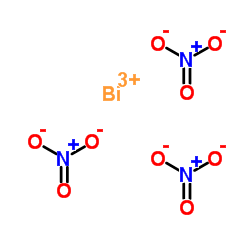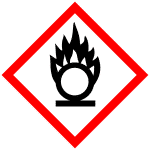bismuth nitrate

bismuth nitrate structure
|
Common Name | bismuth nitrate | ||
|---|---|---|---|---|
| CAS Number | 1304-85-4 | Molecular Weight | 394.995 | |
| Density | 4.928 | Boiling Point | N/A | |
| Molecular Formula | BiN3O9 | Melting Point | 260°C | |
| MSDS | Chinese USA | Flash Point | N/A | |
| Symbol |


GHS03, GHS07 |
Signal Word | Danger | |
Use of bismuth nitrateBismuth subnitrate (Bismuth(III) oxynitrate) is a bismuth(III) compound that bears significant medical uses (e.g., as an antidiarrheic agent). Bismuth subnitrate is a simple, readily available and effective catalyst for the Markovnikov-type hydration of terminal acetylenes[1]. |
| Name | Bismuth hydroxide nitrate oxide |
|---|---|
| Synonym | More Synonyms |
| Description | Bismuth subnitrate (Bismuth(III) oxynitrate) is a bismuth(III) compound that bears significant medical uses (e.g., as an antidiarrheic agent). Bismuth subnitrate is a simple, readily available and effective catalyst for the Markovnikov-type hydration of terminal acetylenes[1]. |
|---|---|
| Related Catalog | |
| References |
| Density | 4.928 |
|---|---|
| Melting Point | 260°C |
| Molecular Formula | BiN3O9 |
| Molecular Weight | 394.995 |
| Exact Mass | 394.943848 |
| PSA | 206.64000 |
| LogP | 0.85230 |
| Stability | Stability Strong oxidizer - contact with combustible material may lead to fire. Incompatible with reducing agents, organic materials. |
CHEMICAL IDENTIFICATION
HEALTH HAZARD DATAACUTE TOXICITY DATA
|
| Symbol |


GHS03, GHS07 |
|---|---|
| Signal Word | Danger |
| Hazard Statements | H272-H315-H319-H335 |
| Precautionary Statements | P210-P220-P221-P305 + P351 + P338-P370 + P378 |
| Hazard Codes | O,Xi |
| Risk Phrases | 8-36/37/38 |
| Safety Phrases | S17-S26-S36/37/39 |
| RIDADR | UN 1477 5.1/PG 2 |
| WGK Germany | 3 |
| RTECS | EB2977000 |
| Packaging Group | II |
| Hazard Class | 5.1 |
|
Bismuth iodoform paraffin paste: a review.
J. Laryngol. Otol. 125(9) , 891-5, (2011) This article reviews the literature pertaining to bismuth iodoform paraffin paste.Bismuth iodoform paraffin paste is used in most otolaryngology departments on a daily basis. Questions about its prope... |
|
|
Comparison of the efficacy of cloxacillin alone and cloxacillin combined with an internal teat sealant for dry-cow therapy.
Vet. Rec. 162(21) , 678-84, (2008) All the quarters in the cows with high somatic cell counts in 10 herds were treated at drying off with either 600 mg cloxacillin or 600 mg cloxacillin and 4 g of an internal teat sealant containing 65... |
|
|
Physiology of sulfide in the rat colon: use of bismuth to assess colonic sulfide production.
J. Appl. Physiol. 92(4) , 1655-60, (2002) Colonic bacteria produce hydrogen sulfide, a toxic compound postulated to play a pathogenetic role in ulcerative colitis. Colonic sulfide exposure has previously been assessed via measurements of feca... |
| Bismuth(III) subnitrate |
| Bismuth(3+) trinitrate |
| Bismuth subnitrate |
| bismuth nitrate |
| Bismuth(III) nitrate |
| EINECS 233-792-3 |
| MFCD00064844 |

